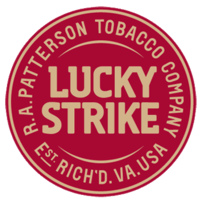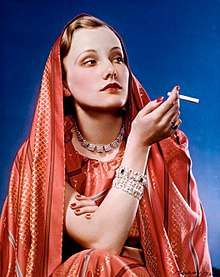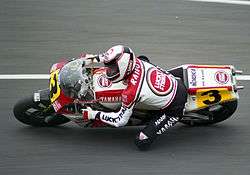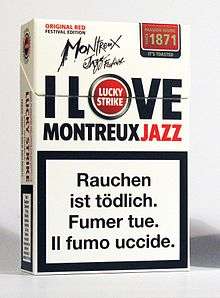Lucky Strike
Lucky Strike is an American brand of cigarettes owned by the British American Tobacco group. Individual cigarettes of the brand are often referred to colloquially as "Luckies". Lucky Strike was the top-selling cigarette brand in the United States during the 1930s and 1940s.[1]
 | |
| Product type | Cigarette |
|---|---|
| Owner | British American Tobacco Japan Tobacco R. J. Reynolds Tobacco Company (U.S. only) |
| Country | United States |
| Introduced | 1871 |
| Markets | See Markets |
| Previous owners | "R.A. Patterson" |
| Tagline | "It's toasted" "L.S. / M.F.T." (Lucky Strike Means Fine Tobacco) |
Name
Lucky Strike was introduced as a brand of chewing tobacco by American firm R.A. Patterson in 1871, although it had evolved into a cigarette by the early 1900s. The brand name was inspired by the gold rushes of the era, during which only about four miners in a thousand were fortunate enough to strike gold, and was intended to connote a top-quality blend.
A well-circulated urban legend holds that the name "Lucky Strike" referred to the presence of marijuana in some cigarette packs.[2]
History

The brand was first introduced by R.A. Patterson of Richmond, Virginia, in 1871 as cut plug and later a cigarette. In 1905, the company was acquired by the American Tobacco Company (ATC).

In 1917, the brand debuted the slogan "It's Toasted" to tout the manufacturing method of toasting, rather than sun drying, the tobacco, a process claimed to improve the flavor of the product.
In the late 1920s, the brand was sold as a route to thinness for women, one typical ad said, "Reach for a Lucky instead of a sweet." [3] Sales of Lucky Strikes increased by more than 300% during the first year of the advertising campaign. In the early 1930s, Al Jolson was also paid to endorse the brand; he called Lucky Strike "the cigarette of the acting profession...the good old flavor of Luckies is as sweet and soothing as the best 'Mammy' song ever written."[4] Sales went from 14 billion cigarettes in 1925 to 40 billion in 1930, making Lucky Strike the leading brand nationwide.[5]
Lucky Strike's association with radio music programs began during the 1920s on NBC. By 1928, the bandleader and vaudeville producer B. A. Rolfe was performing on radio and recording as "B.A. Rolfe and his Lucky Strike Orchestra" for Edison Records. In 1935, ATC began to sponsor Your Hit Parade, featuring North Carolina tobacco auctioneer Lee Aubrey "Speed" Riggs (later, another tobacco auctioneer from Lexington, Kentucky, F.E. Boone, was added). The weekly radio show's countdown catapulted the brand's success, remaining popular for 25 years. The shows capitalized on the tobacco auction theme and each ended with the signature phrase "Sold, American".[6]
In 1934, Edward Bernays was asked to deal with women's apparent reluctance to buy Lucky Strikes because their green and red package clashed with standard female fashions. When Bernays suggested changing the package to a neutral color, George Washington Hill, head of the American Tobacco Company, refused, saying that he had already spent millions advertising the package. Bernays then endeavored to make green a fashionable color.[7] The centerpiece of his efforts was the Green Ball, a social event at the Waldorf Astoria, hosted by Narcissa Cox Vanderlip. The pretext for the ball and its unnamed underwriter was that proceeds would go to charity. Famous society women would attend wearing green dresses. Manufacturers and retailers of clothing and accessories were advised of the excitement growing around the color green. Intellectuals were enlisted to give highbrow talks on the theme of green. Before the ball had actually taken place, newspapers and magazines (encouraged in various ways by Bernays's office) had latched on to the idea that green was all the rage.[8]
The company's advertising campaigns generally featured a theme that stressed the quality of the tobacco purchased at auction for use in making Lucky Strike cigarettes and claimed that the higher quality tobacco resulted in a cigarette with better flavor. American engaged in a series of advertisements using Hollywood actors as endorsers of Lucky Strike, including testimonials from Douglas Fairbanks, concerning the cigarette's flavor, often described as delicious due to the tobacco being toasted.[6] In 1937-38, American Tobacco paid the equivalent of $3.8 million in 2019 USD to 16 Hollywood actors and actresses for their endorsement of Lucky Strike, the highest paid being Joan Crawford and Gary Cooper, who were each paid $10,000 (roughly $178,000 in 2019 USD).[9][10] "Luckies" were the cigarette of choice for the famous smoker Bette Davis, who smoked them until the final years of her life (the New York Times noted the year of her death that she had switched them for Vantage filtered cigarettes).[11]
Beginning in the fall of 1944, Lucky Strike was also a sponsor of comedian Jack Benny's radio and TV show, The Jack Benny Program, which was also introduced as The Lucky Strike Program.[12]
The brand's signature dark-green pack was changed to white in 1942. In a famous advertising campaign that used the slogan "Lucky Strike Green has gone to war", the company claimed the change was made because the copper used in the green color was needed for World War II.[13] American Tobacco actually used chromium to produce the green ink, and copper to produce the gold-colored trim. A limited supply of each was available, and substitute materials made the package look drab.[14]
The white package actually was introduced to modernize the label and to increase the appeal of the package among female smokers; market studies showed that the green package was not found attractive by women, who had become important consumers of tobacco products. The war effort became a convenient way to make the product more marketable while appearing patriotic at the same time.[14]
Famed industrial designer Raymond Loewy was challenged by company president George Washington Hill to improve the existing green and red package, with a $50,000 bet at stake. Loewy changed the background from green to white, making it more attractive to women, as well as cutting printing costs by eliminating the need for green dye. He also placed the Lucky Strike target logo on both sides of the package, a move that increased both visibility and sales. Hill paid off the bet.[15]
The message "L.S./M.F.T." ("Lucky Strike means fine tobacco") was introduced on the package in 1945.
Lucky Strike was one of the brands included in the C-rations provided to US combat troops during the Second World War. Each C ration of the time included, among other items, nine cigarettes of varying brands because at the time, top military brass thought that tobacco was essential to the morale of soldiers fighting on the front lines. The other cigarette brands included in the C-rations were Camel, Chelsea, Chesterfield, Craven "A"-Brand, Old Gold, Philip Morris, Player's, Raleigh, and Wings. The practice of including cigarettes in field rations continued during the Korean and Vietnam Wars, ending around 1975 or 1976 with the growing knowledge that smoking caused various kinds of health problems.[16]
Post World War II
In 1978 and 1994, export and US rights were purchased by Brown & Williamson. In the 1960s, filtered styles were launched in addition to a mentholated version called "Lucky Strike Green". This time "Green" was referring to menthol and not to the overall package color. In late 2006, both the Full Flavored and Light filtered varieties of Lucky Strike cigarettes were discontinued in North America. However, Lucky Strike continued to have marketing and distribution support in territories controlled by BAT as a global brand. In addition, R. J. Reynolds continues to market the original, nonfilter Lucky Strikes in the United States. Lucky Strike currently has a small base of smokers.[17][18]
In 2007, a new packaging of Lucky Strikes was released, with a two-way opening which split seven cigarettes from the rest. In the same year, the company used the world's smallest man, He Pingping, in their ad campaigns.
In 2009, Lucky Strike Silver (the brand marketed as lighter) changed their UK packs from the quintessential red design to blue, albeit with a red teaser outer covering the packet.
In 2012 consumption of Lucky Strikes stood at 33 billion packets, up from 23 billion in 2007. The television series Mad Men, which featured Lucky Strike as a major client of the advertising firm Sterling Cooper and the cigarette of choice of Don Draper, was credited with inspiring the massive jump in sales.[19]
Sport sponsorship
_qualifying_at_USGP_2005.jpg)

From 1972 until the team's departure in 1975, Lucky Strike sponsored the Scuderia Scribante team, which were also known as "Neville Lederle" and "Lucky Strike Racing". The cars, driven by Neville Lederle and Dave Charlton, were some of the first to be sponsored by a major tobacco company after the Lotus Team got sponsored by Gold Leaf in 1968, and Marlboro started sponsoring British Racing Motors in 1972 and later McLaren in 1974.[20][21] The team mainly participated in the South African Grand Prix in Kyalami, but during the 1972 Formula One season, the team also participated in the French Grand Prix in Circuit de Charade, the British Grand Prix in Brands Hatch and the German Grand Prix at the old Nürburgring.[22][23] After the retirement of the team, it would take more than 20 years before Lucky Strike would participate in Formula 1 again with the British American Racing team.
As a result of British American Tobacco (BAT) buying out American Tobacco Company in 1976, Lucky Strike came under control of BAT. The company acquired Formula 1's Tyrrell Racing team in 1997 and rebranded it as British American Racing the following year, sponsoring the team with its Lucky Strike and stablemate 555 brands. In the team's début season, they originally wanted to brand Jacques Villeneuve's car in the red and white Lucky Strike livery, while branding Ricardo Zonta's car with the blue colours of 555. However, the FIA blocked the move, and the team were forced to run two similar liveries. They opted to have the Lucky Strike livery on the left hand side of the car and the 555 livery on the right hand side, with a zip going up in the middle of the nose. From 2000 on, the team solely used Lucky Strike branding. The team was bought outright by partners Honda by 2006, though Lucky Strike continued to sponsor the team until the end of that year.[24][25] For races where tobacco branding wasn't allowed, the Lucky Strike logo was blocked out (from 1999-2004), replaced by "Run Free" on other parts of the car (in 1999), changed to "Look Alike" (from 2000-2003), to a barcode with Formula One cars (in 2003-2004), to "Look Left", "Look Right", and "Don't Walk" (in 2004), and "Racing Revolution" (in 2005-2006).
Lucky Strike was also the prime sponsor of the Suzuki MotoGP team from the 1990 season until the 1997 season. American motorcycle racer Kevin Schwantz became the 1993 world champion riding the Lucky Strike sponsored Suzuki RGV500, with riders such as Doug Chandler, Alex Barros and Daryl Beattie taking various podiums and wins on the Lucky Strike Suzuki as well.[26][27][28][29][30]
In popular culture
The cigarette brand is referenced in many modern forms of media.
In art
- American Colonial-Cubist artist Stuart Davis represented the brand in his 1921 painting, Lucky Strike.[31]
In music

- The song "Give it Back to the Indians" composed by Rodgers and Hart from the 1939 musical Too Many Girls, contains a reference to Lucky Strikes.
- The song "So Round, So Firm, So Fully Packed", written by Merle Travis, Eddie Kirk, and Cliffie Stone in 1947, is named for a Lucky Strike advertising slogan.
- The song "I'm Bad, I'm Nationwide" performed by ZZ Top from their 1979 album Degüello, contains a reference to Lucky Strikes.
- The song "Keeping the Faith" performed by Billy Joel from his 1983 album An Innocent Man, contains a reference to Lucky Strikes.
- Minneapolis indie rock band Howler based the artwork of their debut album America Give Up on a pack of Lucky Strikes.[32]
- A song named after the cigarettes appears on the Maroon 5 album, Overexposed.
- A song named after the cigarettes appears on the Troye Sivan album, Bloom.
In television
- In the AMC television series Mad Men, Lucky Strike is a major client for the fictional advertising agency Sterling Cooper. A fictitious plot is also presented for the birth of the slogan "It's Toasted", in the series' pilot episode, "Smoke Gets in Your Eyes". The main character, Don Draper, is often seen smoking Lucky Strikes.
- In the NBC television series Miami Vice, Lucky Strike is the preferred cigarette brand of main character, Detective James "Sonny" Crockett. He is even seen removing the filter of a different brand of cigarette in a particular episode to make it smoke more like a Lucky Strike.
In video games
- In the Metal Gear videogame series, Lucky Strike is Solid Snake's favorite brand of cigarettes.
Manga
In the manga Last Inning by Ryu Kamio, the Protagonist, Keisuke Hatogaya consume of these cigarettes, the first direct reference being chapter 4 of the first volume.
Cigarette camp
"Lucky Strike" was the name of one of a number of temporary U.S. Army "tent cities" known as Cigarette Camps situated around the French port of Le Havre following its capture in the wake of the Allied D-Day invasion in mid-1944.[33]
See also
References
- Brandt, Allan (January 6, 2009). The Cigarette Century: The Rise, Fall, and Deadly Persistence of the Product that Defined America. Avalon Publishing Group. p. 75. ISBN 978-0-7867-2190-0. Retrieved August 28, 2015.
- "Marijuana in Lucky Strike". Snopes.com. Retrieved 12 May 2017.
- Manitoba. (2010). Back off tobacco: tobacco education for Manitoba students, K-12 = Dire au tabac: programme de prv̌ention de lusage du tabac pour les ľv̈es du Manitoba, M ̉12. Winnipeg.
- "Hollywood 'paid fortune to smoke'". BBC News. 2008-09-25. Retrieved 2019-07-18.
- Columbia University National Center on Addiction and Substance Abuse (2006). Women Under the Influence. JHU Press. p. 21. ISBN 978-0-8018-8227-2. Retrieved 28 August 2015.
lucky strikes cigarettes.
- Lum, K. L.; Polansky, J.R.; Jackler, R.K.; Glantz, S.A. (28 September 2008). "Signed, sealed and delivered: 'Big tobacco' in Hollywood, 1927-1951". Tobacco Control. 17 (5): 313–323. doi:10.1136/tc.2008.025445. PMC 2602591. PMID 18818225.
- Larry Tye, The Father of Spin (1999) , p. 35-38.
- Tye (1999), p. 39. "Vogelman signed up and invited fashion editors to the Waldorf for a Green Fashions Fall Luncheon with, of course, green menus featuring green beans, asparagus-tip salad, broiled French lamb chops with haricots verts and olivette potatoes, pistachio mousse glacé, green mints, and crème de menthe. The head of the Hunter College art department gave a talk entitled "Green in the Work of Great Artists," and a noted psychologist enlightened guests on the psychological implications of the color green. The press took note, with the New York Sun headline reading, "It looks like a Green Winter." The Post predicted a "Green Autumn," and one of the wire services wrote about "fall fashions stalking the forests for their color note, picking green as the modish fall wear."
- "Hollywood 'paid fortune to smoke'". BBC News. 2008-09-25. Retrieved 2019-07-18.
- "US Inflation Calculator". Retrieved 2019-07-18.
- Glenn Collins (1989-04-20). "Tribute for a Dauntless Bette Davis. Yes". New York Times. Retrieved 2019-07-18.
- "ARTICLE: "The Jack Benny Program and Lucky Strikes" - Jack Benny in the 1940s". sites.google.com. Retrieved 2020-02-15.
- Heide, Robert; Gilman, John. Home Front America: Popular Culture of the World War II Era. pp. 128–129. ISBN 0-8118-0927-7. OCLC 31207708.
- Mikkelson, David (8 May 2011). "Lucky Strike Logo Color Change". Fact Check. Snopes Media Group Inc. Retrieved 15 July 2019.
- "Raymond Loewy: Biography". Raymondloewy.com. 2015. Retrieved August 28, 2015.
- "U.S. Army Rations - C-rations". Usarmymodels.com. March 30, 1943. Archived from the original on July 15, 2019. Retrieved July 15, 2019.
- "Company - Brands - Brand Portfolio". R.J. Reynolds Tobacco Company. 2008. Archived from the original on August 22, 2008. Retrieved August 28, 2015.
- "Our brands". British American Tobacco. 2015. Retrieved August 28, 2015.
- "Mad Men boost for Lucky Strike cigarettes angers campaigners". Daily Telegraph. 2013-09-22. Retrieved 2019-04-22.
- "Dave Charlton". Pinterest. Retrieved 4 January 2018.
- "Scuderia Scribante". Laberezina.com. Retrieved 4 January 2018.
- "TRIBUTE: DAVE CHARLTON, THE END OF AN ERA". Raceweb.co.za. Retrieved 4 January 2018.
- "Scuderia Scribante". Motorsportmagazine.com. 12 June 2017. Retrieved 4 January 2018.
- "Honda bedankt Lucky Strike en Michelin". GPUpdate.net. Retrieved 4 January 2018.
- "2005: Lucky Strike BAR Honda". F1colours.com. 12 January 2017. Retrieved 4 January 2018.
- Sports, Dorna. "MotoGP™". Motogp.com. Retrieved 4 January 2018.
- "30 years of the Suzuki RGV500". Motorcyclenews.com. Retrieved 4 January 2018.
- "Two-stroke Tribute: Lucky Strike Suzuki RGV500". Cycleworld.com. Retrieved 4 January 2018.
- "Kevin Schwantz - 1993 World GP MotorCycle Championship Title Tables". Kevinschwantz.com. Retrieved 4 January 2018.
- "Whatever happened to MotoGP's fag money?". Motorcyclenews.com. Retrieved 4 January 2018.
- Glennon, Jen (2017) Artist David Stuart Artworks The Art Story Foundation
- MacBain, Hamish (January 13, 2012). "NME Reviews - Howler - 'America Give Up'". NME. Retrieved August 28, 2015.
- "Historic American Engineering Record: SS Maritime Victory (Private Frederick C. Murphy)" (PDF). United States Maritime Administration. 2006. p. 5. Retrieved August 28, 2015.
The ship made crossings in 1946 carrying troops between the European Theater of Operations, especially Le Havre, France, and New York City, New York. From Le Havre, the ship often left from the area known as the 'Cigarette Camps'.
External links
| Wikimedia Commons has media related to Lucky Strike. |
- Collection of mid-twentieth century advertising featuring Lucky Strike cigarettes from The TJS Labs Gallery of Graphic Design.
- "Lucky Strikes?" by Barbara Mikelson at snopes.com (June 12, 2006)
